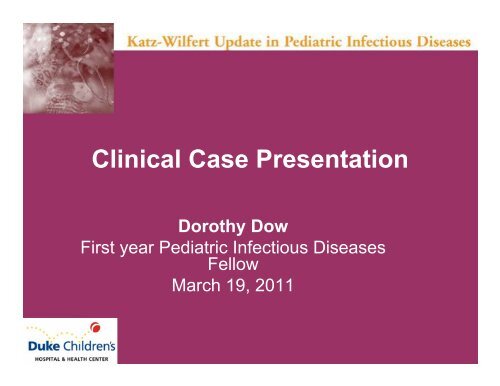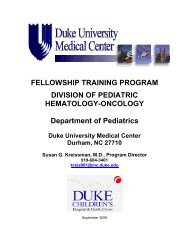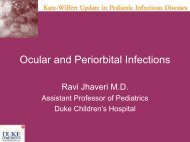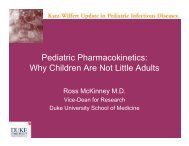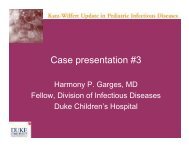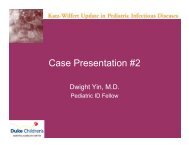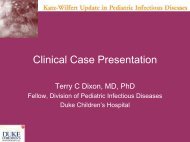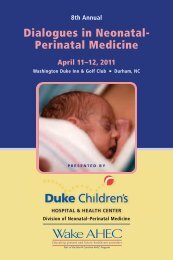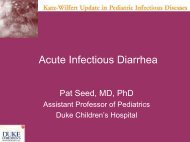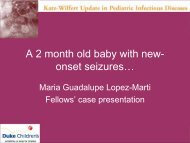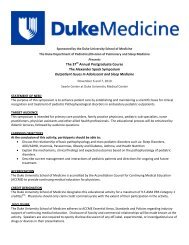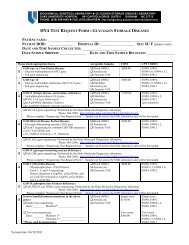Clinical Case Presentation #1 - Dorothy Dow, MD - Duke ...
Clinical Case Presentation #1 - Dorothy Dow, MD - Duke ...
Clinical Case Presentation #1 - Dorothy Dow, MD - Duke ...
- No tags were found...
Create successful ePaper yourself
Turn your PDF publications into a flip-book with our unique Google optimized e-Paper software.
<strong>Clinical</strong> <strong>Case</strong> <strong>Presentation</strong><strong>Dorothy</strong> <strong>Dow</strong>First year Pediatric Infectious DiseasesFellowMarch 19, 2011
<strong>Clinical</strong> <strong>Presentation</strong>August 1, 2010•! 11 y/o male•! 1 day history of bilateral frontalheadaches, nuchal rigidity, photophobia,and emesis X3•! Within 12 hours patient with dysnomia(difficulty remembering words) andcompleting sentences•! Afebrile.•! No other symptoms: DENIES diarrhea,rash, joint pain, dysuria, arthralgia,myalgia•! No prior history of Headache nor sinusitis•! MOC brought patient in to seek medicalcare
Further History•!•!•!•!•!•!•!PMH: negSurgical hx: noneAllergies: Penicillin !HIVESIMM: UTD including MCV4FHx: none relevantSocial: lives in Roxboro with mom,dad, 8 y/o sister all well. No Pets. Ptentering 5 th grade, plays footballTravel/Exposure: One week prior--boy scout trip to NC mountains andbit by mosquitos. No tick bites. Noother scouts sick.
Physical ExamT: 37.4 C HR: 110 RR: 16 BP: 135/71 mmHg. 97 % RAGen: well developed/Obese. Alert and orientedNeck: nuchal rigidity, pain especially cervicalflexion and on palpation of cervical andthoracic spine. No lymphadenopathyCV: RRR no M/G/RPulm: CTABAb: soft, obese, tender to deep palpation, +BS, no HSMNeuro: strength 5/5 and reflexes 2+ patellar.Neg kernigs/brudzinski on initial exam
LABS•! Initiallywbc 20.6 hg 13.6 plt 26981% pmn 8% band 8% lymph 3%monoSodium 135, Cr 0.6AST 24 ALT 14CSF:rbc 2000, wbc 440, 88% pmn ,12% lymph,Glucose 71 mg/dl, Protein 28 mg/dl•! MICRO: CSF•!Gram stain without organism,moderate PMNsHSV and Enteroviral PCR neg•! MICRO: SerumLyme PCR negRMSF serology sentBlood culture No growthHIV negative
Questions so far?…the pager went off and this is yournew consult
CONSULTBased on CSF, likely viral process<strong>Clinical</strong>ly, Patient continued tohave fever up to 40 C withintermittent AMS and neckstiffness•! MRI on 8/6/2010 within normal limits•! Repeat LP on 8/6/2010wbc 27 rbc 4 10% pmn 76% lymph10% mono 3% Variable lymph 1%ependymal cellsProtein 38 Glucose 51HSV and Enterovirus PCR again negARBOVIRAL PANEL SENT•! 1:1024, REACTIVE, to LaCrossevirus IgG by IFA and IgMPOSITIVE by ELISA•! CSF (8/6/10) titer is 1:32,REACTIVE, to LaCrosse virusIgG by IFA and IgM POSITIVE byELISA•! Testing performed by THE NCSTATE LABORATORY OFPUBLIC HEALTH
La Crosse Virus (LACV)•!•!•!•!Member of genusOrthobunyavirus, familyBunyaviridae.Vector is the Ochlerotatustriseriatus, formerly Aedestriseriatus, eastern treeholemosquitoUnlike West Nile virusinfections (more severe inadults) LACV more severe inchildren8-30% all encephalitis andMOST COMMON arboviralinfection in childrenHaddow, Andrew. PLoS One V 4(7); 2009
La Crosse County, Wisconsin1960: 1 st case 4 y/o girl died of “ruralencephalitis” (thought to havebeen infected in Minnesota).1964 Dr. Wayne Thompson andcolleagues isolate the virus(90-100 mm) from patients braintissueLarge, Medium, Small genomesegmentsL: viral polymeraseM: process into viralglycoproteins G1 (fusion) andG2! major determinant for viralneuroinvasivenessS: encodes N proteinViral envelope is host derivedPhoto courtesy of Dr Ray Baumann from the Dept. of Microbiology, University of Mississippi Medical Center
Enzootic CyclePhoto courtesy of Medical Microbiology. 4th edition.Baron S, editor.Galveston (TX): University of Texas Medical Branch at Galveston; 1996.
LACE: La Crosse Encephalitis•! Principally a diseaseof children•! 1972-1981 75% werechildren under 10years•! 2:1 malepredominance•! Annual incidence is10-30/100,000children under 15Feign and Cherry
Incidence of La CrosseFeign and Cherry
Confirmed <strong>Case</strong> definitionLaboratory Criteria•! Four-fold or greaterchange in virus-specificserum antibody titer, or•! Isolation of virus fromtissue, blood, CSF, otherbody fluid, or•! Virus-specific IgM Ab inCSF or Serum andConfirmed by IgG<strong>Clinical</strong> criteria•! FEVER AND–! Acutely altered mentalstatus, or–! Other acute signs ofcentral, or peripheralneurologic dysfunction, or–! Pleocytosis associated withillness clinically compatiblewith meningitisHaddow, Andrew. PLoS One V 4(7); 2009
Geographic distributionHaddow, Andrew. PLoS One V 4(7); 2009
Incidence MapHaddow, Andrew. PLoS One V 4(7); 2009
Spacial DistributionHaddow, Andrew. PLoS One V 4(7); 2009
Other Arbovirus•! West Nile:1 st 1937 in West Nileregion of UgandaWestern Hemisphere in1999 in NYC (importedfrom Middle East)Now leading cause ofarboviral encephalitisin the US.Most are asymptomaticHaddow, Andrew. PLoS One V 4(7); 2009
ARthropod BOrn VirusGenera Type/discovery Interesting facts Amplifing host: vectorAlphavirus (Togavirus)WEE; in b/t belowEEE: least prev; highestmortalityVEE: most susceptible; leastvirulentCHIKungunya (OLD WORLD)Small enveloped +RNA1 st Ag + neuronal cells inhamster model EEE arebasal ganglia and brainstem then periventricular(Arthritis and Rash)Use in gene therapy??potential bioterrorismIn 2005-2006 La Reunionoutbreak and spread toIndia, Sri Lanka,Indonesia!07 ItalyBirds, Rodents, Horses:culexculiseta, AedesOld world primates; AedesmosquitoFlavivirus (NEW WORLD)yellow fever, west nile (1st),dengue, JapaneseencephalitisENCEPHALITISSpherical, enveloped, +SSRNAAVIAN; Culex mosquitoBunyaviridae (New world)Crimean-Congo HFV (2 nd )LaCrosseRift valley feverENCEPHALITISDiscovered in Kenya 1931(enzootic hepatitis) inewes!1977 to Nileregion/Egypt 200,000infections; 594+death!2000 Yemen andSaudi ArabiaInterferon is important inlimiting severity of CNS dz;however, interferonresponse is inhibited byRVFV and NSs proteinblocks interferon productionby targeting RNA poly IIcomplex down-regulatinghost transcriptionSquirrel/chipmunk: Aedes(sudden development ofabortion “storms” in livestockafter heavy rainfall)
In Summary•!•!•!•!La Crosse severity worse inPediatrics v. West Nile worsein AdultsNo good treatment optionsPrevention and anticipatoryguidance is importantClinicians should maintain ahigh clinical suspicion forLACV for pediatric patientswith unexplainedmenigoencephalitisCDC Neato Mosquito
References•! McJunkin JE, Minnich LL. La Crosse encephalitis and other Californiaserogroup viruses. In: Feign RD, Cherry JD, eds. Textbook of pediatricInfectious Diseases. 6 th ed. Philadelphia, PA: Saunders. 2009;2557-68.•! CDC. La Crosee encephalitis. Atlanta, GA: US Department of Health andHuman Services, CDC; 2009. Available at http://www.cdc.gov/lac.Accessed March 17, 2011.•! Bradley S. Hollidge, Francisco Gonzalez-Scarano, Samantha S. Soldan.Arboviral Encephalitides: Transmission, Emergence, and Pathogenesis. JNeuroimmune Pharmacology 2010 5: 428-442.•! La Crosse Virus Neuroinvasive Disease—Missouri, 2009. MMWR. July 23,2010. Vol 59 (28); 869-871•! Andrew Haddow and Agricola Odoi. The Incidence Risk, Clustering, and<strong>Clinical</strong> <strong>Presentation</strong> of La Crosse Virus Infections in the Eastern UnitedStates, 2003-2007. PLoS One. 2009; 4(7): e6145.
QUESTIONS


